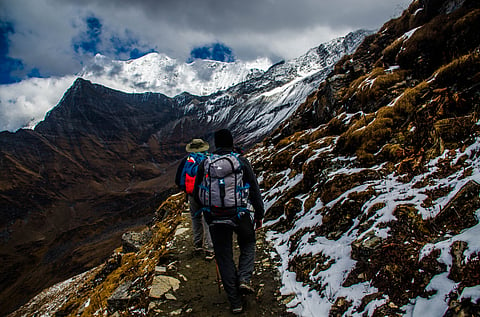
- Destinations
- Experiences
- Stay
- What's new
- Editor’s Picks
- Responsible Tourism
- CampaignsCampaigns
- Subscribe

Trekking is a thrilling adventure that allows you to connect with nature, challenge your physical limits, and explore stunning landscapes. Whether you're embarking on a day hike or a multi-day trek, packing your backpack efficiently is one of the most critical aspects of ensuring a successful and enjoyable journey. A well-packed backpack ensures you have everything you need and contributes to your comfort and safety on the trail. Here, we take you through the essentials of packing your backpack for trekking.
Bottom Zone
You should store infrequently used and bulky items at the bottom of your backpack. These items will provide a foundation for stacking your other belongings on top of them and will ensure that the bottom of the pack isn't too heavy. Since these items will be the hardest to reach while on the trail, it's best to use this space for anything you won't need until you stop to make camp.
Back Middle Zone
When packing for a trip, it's important to remember that you can place your heaviest items in the back middle zone of your backpack. This is because putting heavy items in the middle of your back creates a stable center of gravity that's comfortable to your back and legs over long periods. These heavy items should be things that you won't need until you make camp. To save space, you can fill any cookware or containers with other items, like food or clothing. Examples of items that should be placed in this section include your tent body, cookware, a stove and fuel, beer cans, or food.
Front Middle Zone
Another important tip when packing for a trip is to store light, infrequently needed items in the section of the main backpack compartment that's farthest from your body. This will help ensure balance and comfort while you hike. If an item is very light but you know you'll need it frequently, it's best to save it for the top portion of your backpack or an exterior pocket or pouch. Remember to keep this section light to avoid throwing off your balance. Some of the items to store in this section include a sleeping bag, extra clothing, or a lightweight sleeping pad.
Top Zone
When packing for a hike, it's important to remember that the top portion of your backpack is the easiest to access. This is why it's best to save this space for things you know you'll use on the trail, such as snacks, sunglasses, a raincoat or a poncho, an umbrella, and a water filter. This way, you won't have to stop and unpack everything to grab a snack or other essential item. However, be careful not to overpack this top portion, as too much weight makes you more likely to fall over if you lose your balance.
Outside Pockets
These backpacks are perfect for storing small and easily misplaced essentials. The side and hip belt pockets are great for quickly stashing tiny items that you need to grab often, as they can easily get lost in larger backpacks. Additionally, most hiking backpacks come equipped with a stretchy front pouch, also known as a kangaroo pouch, which is perfect for storing lightweight must-haves that are too big for smaller pockets.
Packing Gaps
To pack your backpack efficiently, start by filling the bottom, middle, and top layers with hard items that have firm shapes. Then, use flexible items like spare clothes, a rain jacket, or a blanket to fill in the remaining space between the hard items. This will help you maximise the space in your backpack and ensure that everything is packed securely.
Loops And Lash On
Some items, such as trekking or tent poles, an ice axe, or even a camping chair, may not fit inside your backpack. You can attach these items to the exterior of your pack, but be sure to distribute their weight evenly for balance and comfort. Remember that large exterior items can be unwieldy and may snag on branches or rocks, so try to attach as few items as possible. Additionally, some hikers choose to lash their sleeping bags outside their backpacks to save space.
Use A Waterproof Rain Cover
It's common to use a cover that goes around the outside of your backpack and fastens around the back panel with a cord. Some backpacks come with one. If there's wet weather in the forecast, pack a cover and take the time to put it on. A wet backpack can be heavy, even if the contents inside are dry. To protect your clothing, electronics, and bedding, put them in plastic bags inside your backpack, even if you have a rain cover.
